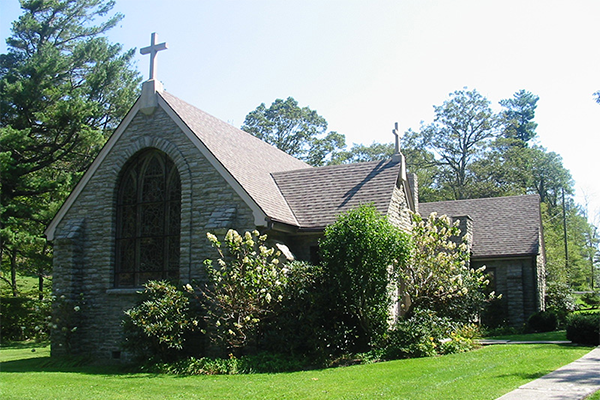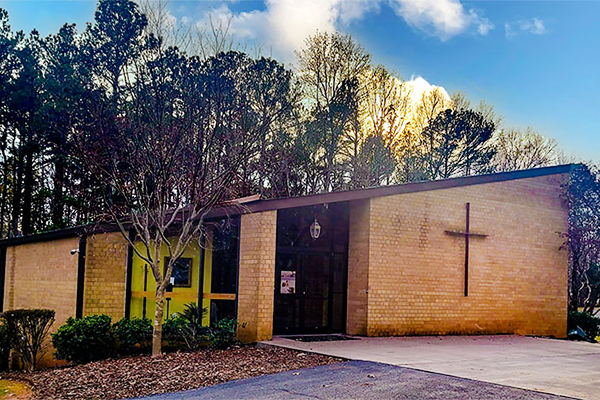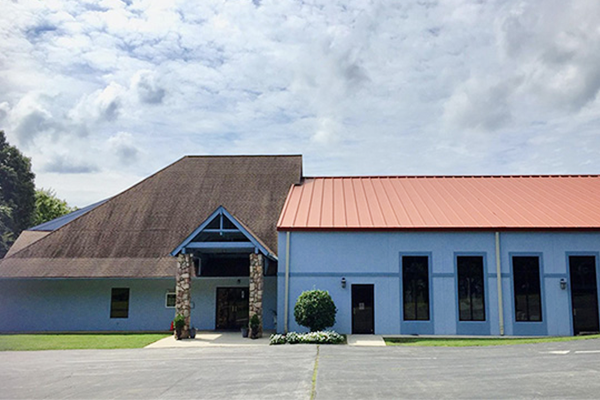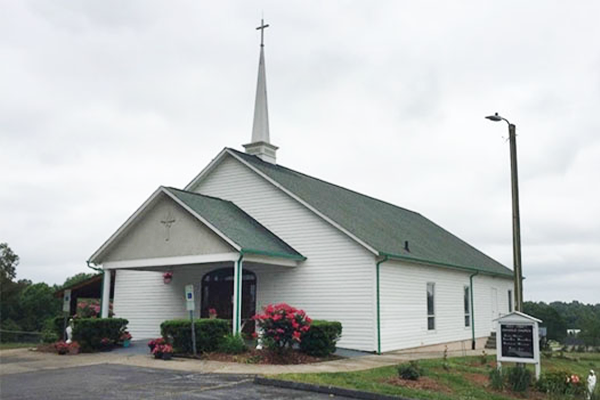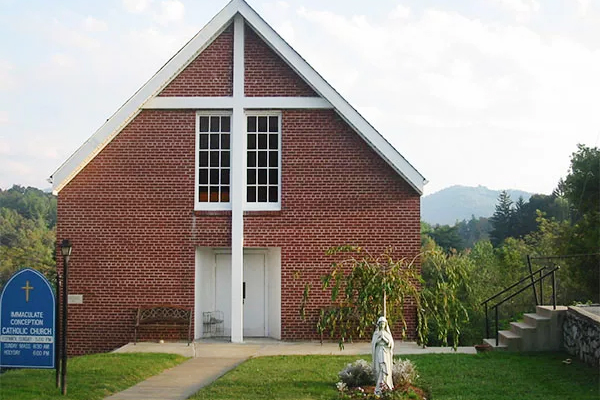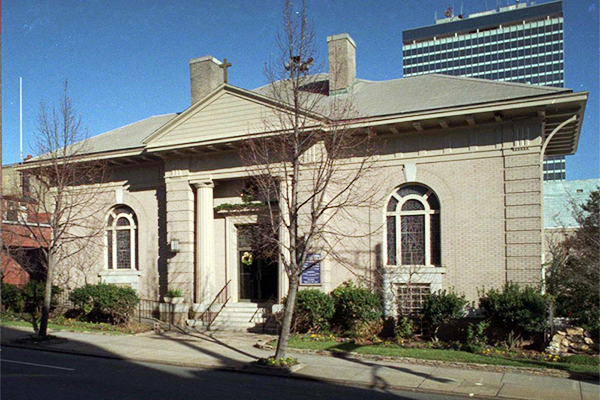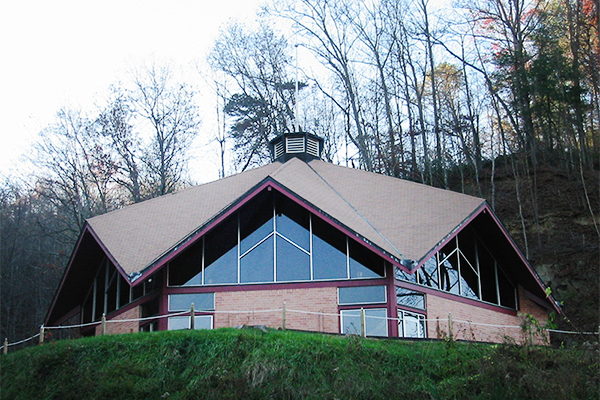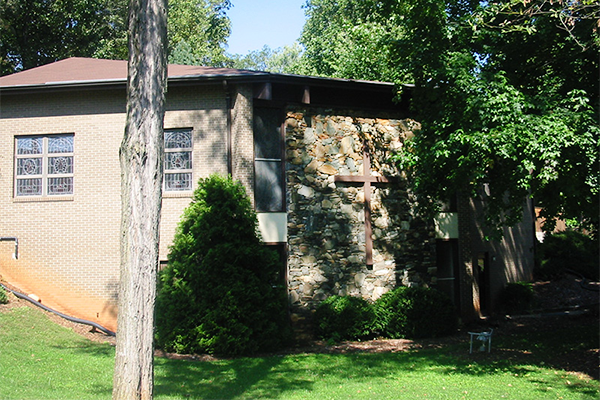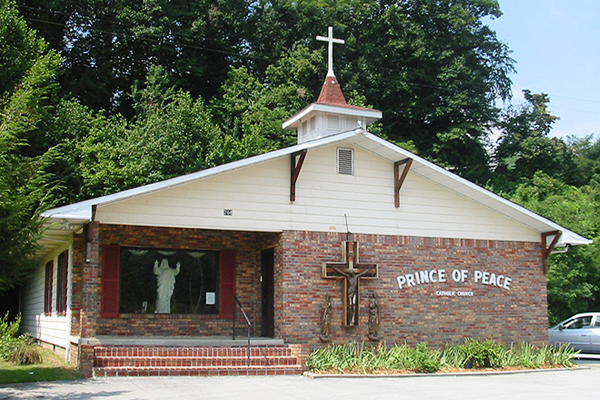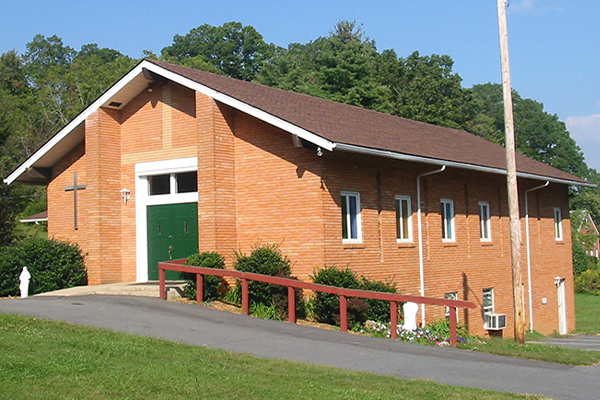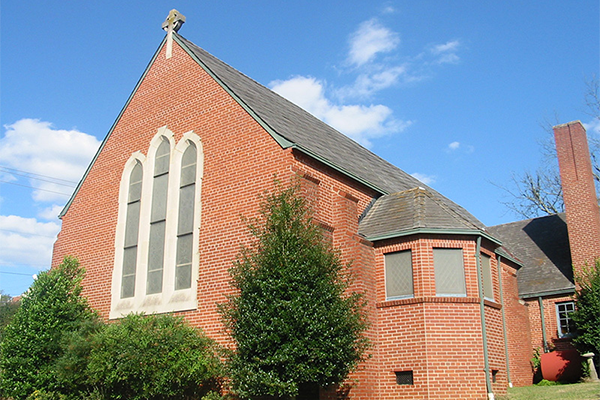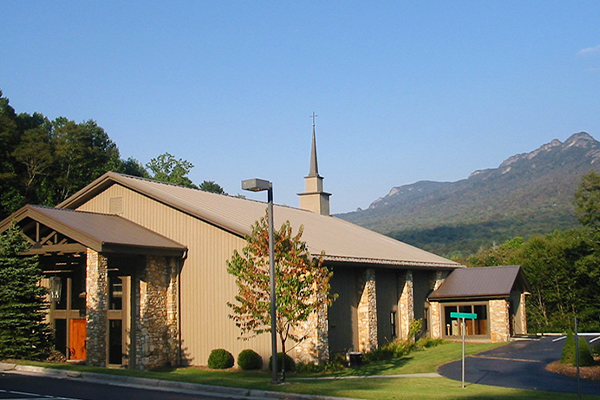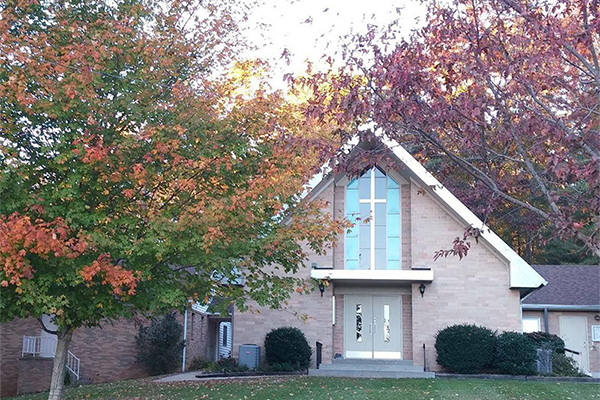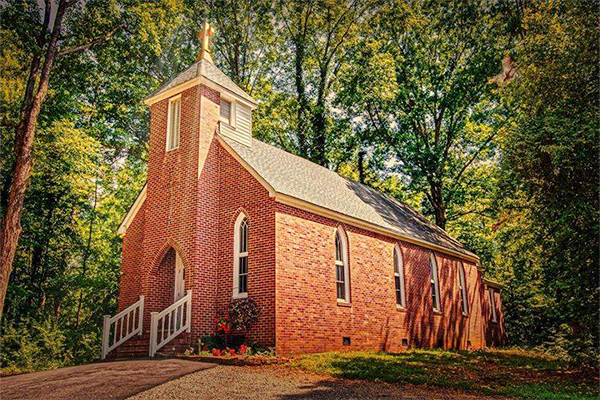Pioneering clergy and laypeople are building up Catholic communities in 17 outlying areas of North Carolina where mission churches are thriving. Discover what life is like in these frontiers of the faith.
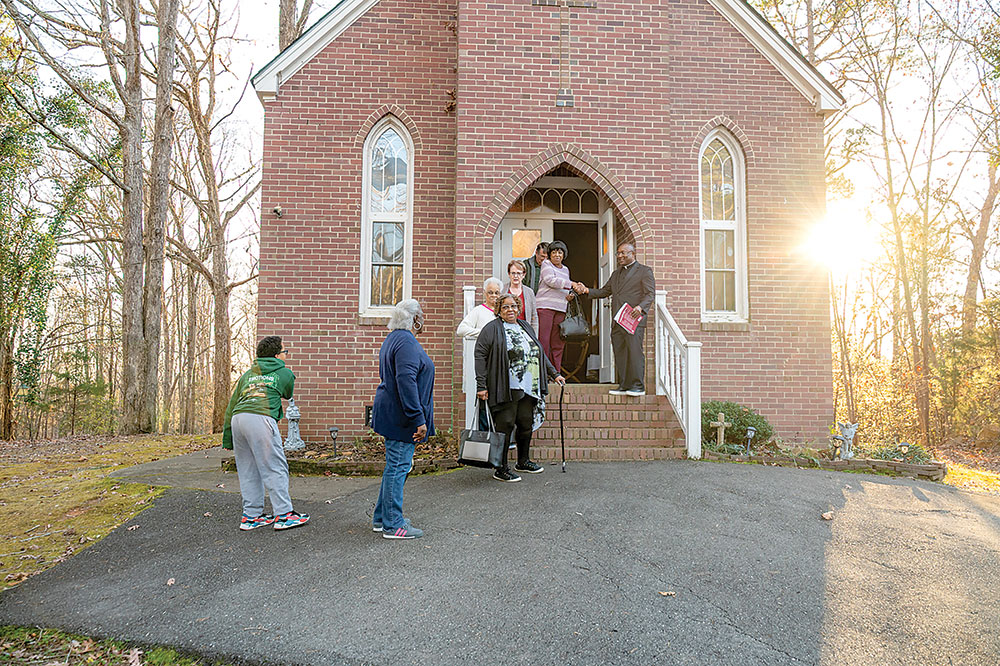 Father Basile Sede and members of St. Helen Mission in Spencer Mountain enjoy fellowship after sprucing up their church for Advent. (Photos provided and by Troy Hull)Father Basile Sede wakes before dawn on Sundays to start his weekly “Spiritual Olympics” – dashing to three different Masses, driving up Spencer Mountain, and navigating urban and rural landscapes, traffic and people. All before noon.
Father Basile Sede and members of St. Helen Mission in Spencer Mountain enjoy fellowship after sprucing up their church for Advent. (Photos provided and by Troy Hull)Father Basile Sede wakes before dawn on Sundays to start his weekly “Spiritual Olympics” – dashing to three different Masses, driving up Spencer Mountain, and navigating urban and rural landscapes, traffic and people. All before noon.
As pastor of Our Lady of Consolation in Charlotte, he celebrates the 8 a.m. Mass at his parish, then drives 25 minutes to offer the 9:30 a.m. Mass at St. Helen Mission near Gastonia, then turns right back around to his Charlotte parish to offer the 11 a.m. Mass.
“It is a rush,” he says, “but it’s important.”
Such is the life of a mission priest – and a mission church.
Typically small congregations in remote or rural areas, missions are part of an extended parish family that usually assists them until they can stand on their own.
“They’re little churches with big hearts, grit and pioneering spirit,” says Monsignor Patrick Winslow, the Diocese of Charlotte’s vicar general and chancellor. “They start small and are devoted to the faith because they love the Lord. And most are determined to one day become a full-fledged parish when their attendance, finances and administration can sustain their operations into the future.”
The Sunday “Spiritual Olympics” play out at most of the diocese’s 17 missions, with priests shuttling from parish churches to missions 30 minutes or an hour away. Many of the missions date back to the 1950s, nearly 20 years before the diocese was even established. Most began with a few families forming a faith community and finding a priest to take on the task – and blessing – of tending to their spiritual needs.
A mission church echoes missionary work in the far reaches of the world. Spreading the Gospel to people across the globe is the reason the Church exists, yet there is still a need for evangelization and shepherding here in our own communities.
The Diocese of Charlotte itself was considered “mission territory” until very recently, when the booming growth of Catholics across the state pushed the diocese past the point of qualifying for Church support of missionary activities to strengthen the Catholic Church in North Carolina.
Still, the high demand for priests means going to great lengths to serve the faithful – just as it did when the Church began in western North Carolina in the 1860s, when priests traveled on horseback to bring the sacraments to the sparsest reaches of the state.
Father Sede of Cameroon embraces his “Olympic” assignment. It’s the second time he’s been called to serve both a parish and a mission, which he sees as the lifeblood of the Church.
“My experience, be it in Cameroon or be it in the United States,” he says, “is that the closer you come to the people, the more the populations are in church.”
Thriving Mission Life
 Father Jose Camilo Cardenas-Bonilla of Holy Trinity Mission in Taylorsville blesses animals on the Feast of St. Francis of Assisi while riding horseback, evoking the early days of the faith in North Carolina when priests traveled on horseback to serve mission territories. Missions in the diocese typically register between 70 and 200 families, most with a mix of cultures and ethnicities. Each is contained within the boundaries of a parish, whose established church often shares in the life of the more remote mission – administratively, financially and spiritually.
Father Jose Camilo Cardenas-Bonilla of Holy Trinity Mission in Taylorsville blesses animals on the Feast of St. Francis of Assisi while riding horseback, evoking the early days of the faith in North Carolina when priests traveled on horseback to serve mission territories. Missions in the diocese typically register between 70 and 200 families, most with a mix of cultures and ethnicities. Each is contained within the boundaries of a parish, whose established church often shares in the life of the more remote mission – administratively, financially and spiritually.
Missions celebrate at least one Sunday Mass, when the parish priest shuttles in from miles away, or in a few cases, they enjoy the luxury of having a priest exclusively dedicated to them. Having diverse populations means everything must be translated into English and Spanish, or duplicated with separate Masses in different languages.
A few missions are seasonal, including Church of the Epiphany in Blowing Rock. The June-through-September staffing of the mountain mission is a response to the influx of vacationing Floridians escaping the summer heat.
When in season, these missions are busy. Other missions stay that way throughout the year.
On Dec. 2, more than a dozen people came out despite morning fog to Our Lady of the Angels in Marion for the 7:45 a.m. Rosary for Life and 8 a.m. Mass. They were greeted by Father Carl E. Kaltreider, aged 80.
After Mass, Father Carl stood in the small church’s entrance laughing and talking with people. Off to the side, members decorated an angel tree with ornaments depicting nativity scenes, available for donations to the McDowell Pregnancy Care Center. As they worked, others carried in wreaths, candles and greenery.
Father John Putnam fondly remembers his service at Cristo Rey Mission back in the 1990s, which met in an old True Value Hardware store in Yadkinville. The mission was filled with migrant workers, who lived in trailers and apartments and were hungry to build a Catholic faith community.
“It was the vitality of the community that allowed them to sustain a mission – and they were active,” says Father Putnam, a new priest then, who drove a half-hour from Clemmons to perform weddings and funerals and baptisms and Mass.
“They were also very kind and patient,” he said, recalling how parishioners politely informed him that instead of calling them “parents,” he was misplacing the accent in his budding Spanish and calling them “potatoes.”
Since most missions are of meager means, they build or rent whatever they can. Sacred Heart Mission had Mass at a local theater in Wadesboro; Our Lady of Fatima in an old library in downtown Winston-Salem; and St. Frances of Rome once gathered in the cafeteria of an old Sparta shoe factory.
Often, there are unsung hero families, priests and supporters who keep these missions alive.
In Hayesville, the Glenmary Home Mission Sisters welcomed the small Catholic community to celebrate Mass in their chapel until it had grown strong enough in 1984 to become a standalone mission.
In Robbinsville in the 1950s, the Catholic community attended Mass in an old storefront and grew over time – finally establishing Prince of Peace Mission in 1988 when its original associate pastor – Glenmary Father James Wilmes – returned after nearly 30 years to find land for a church.
In Canton, where Immaculate Conception would eventually be established as a mission, Mass was celebrated in the YMCA in the early 1950s. The visiting priest brought a makeshift altar: a suitcase containing vestments and altar furnishings, which folded out and propped up on legs.
The missions have come a long way since these pioneering days, but with limited funds and access to a priest, mission life still can be difficult today. There’s an ever-present goal of becoming financially stable enough to become a parish and, in some places, tension between the desire to stay small and wanting to grow. Yet there are immense blessings, too.
Meeting the challenges
As a member of Good Shepherd Mission in King for nearly 30 years, Deacon David Boissey knows what it takes to run a mission church.
As a deacon, he is an ordained minister and able to preside at baptisms, weddings, wakes and funerals. This alleviates some of the back-and-forth for the mission’s priest, Father Melchesideck Yumo, but there are certain things only a priest can do.
Running a parish and a mission is “not for the faint of heart,” Deacon Boissey says. “It’s a big drain on the priest to have two parishes.” But they learn to juggle.
Beyond the travel, Deacon Boissey says, the priest has administrative responsibility of two entities with separate budgets, expenses, personnel and often different languages.
Although there are similarities, each mission in the diocese is unique.
Head west from King to find Father Cory Catron, who has a 45-minute, sometimes harrowing mountain drive between St. Francis of Assisi Church in Jefferson and St. Frances of
Rome Mission in Sparta. He arrives early for Mass to offer Eucharistic Adoration and stays afterward to hear confessions – which puts him on the road at all hours.
“Father Cory stays really involved with Bible study groups and book discussion groups,” says Carla Gauldin, the mission’s administrative assistant.
She and Father Catron note that both churches are split 50/50 between white and Hispanic populations, which sometimes makes it feel like four churches instead of two.
“With both churches split, Father Cory gears his ministerial efforts just as much for Spanish as English,” Gauldin says. It’s more work, but necessary.
Father Catron wants to minister to the needs of each group, he says, while also bringing them together to function as one.
Missions also struggle to find space for burgeoning faith formation classes, a good problem to have.
“We desperately need a building for our classrooms right now,” Deacon Boissey says. “When we’ve run out of classrooms, we’ve used any available space such as renting from a local daycare, using the church’s cry room and even the church itself one year. More recently, we have combined classes and used a trailer. We run out of space quickly, but to the best of my knowledge, we’ve never turned anyone away.”
Enjoying the blessings
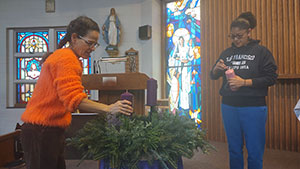 Members of Our Lady of the Angels Mission in Marion decorate the church for Advent.Through his experience, Deacon Boissey can see the bigger picture of mission life.
Members of Our Lady of the Angels Mission in Marion decorate the church for Advent.Through his experience, Deacon Boissey can see the bigger picture of mission life.
“Through struggles you earn blessings, and the people will rise to the occasion when God calls them,” he says. “One of the things you really see here at Good Shepherd is a lot of good people who work hard and cooperate with the priests.”
He also notes that one member recently painted the interior of the church at no charge, while also juggling family and the demands of his full-time job.
In Taylorsville, Father Jose Camilo Cardenas-Bonilla, pastor of Holy Trinity Mission, appreciates the involvement of the members and close-knit community.
“In the beginning I was little afraid because there was no money and the mission needed a lot of repairs, but in this case you have to say, ‘Thank you, God,’ because the people are very generous, and we are keeping things in good shape,” he says.
Father Carl Kaltreider in Marion serves a predominately Hispanic membership at Our Lady of the Angels. In his 13th year, it is the longest he has pastored at one church – and he is one of only two priests in the diocese assigned exclusively to a mission.
“I had not intended to stay here beyond the retirement age of 70, but here I am, already 80 years of age,” he says. “I’ve really loved the ministry here and the people, because I still have the desire, health and zeal for active parish ministry.”
Father Kaltreider established the first Hispanic Knights of Columbus Council in North Carolina at Our Lady of the Angels – Council 17058 – and teaches sacramental prep courses himself. He also works with young people and has enjoyed watching them grow and develop in the faith since they were infants.
“I’ve taught the confirmation class every year, and I’ve had up to 60-some students,” he says. “It’s a two-year program, and I teach both years together. Of the 41 students in the class now, I’ve baptized all but two, gave First Communion to all but four, and presided at the wedding of my first confirmation student, age 23.”
Urban and rural
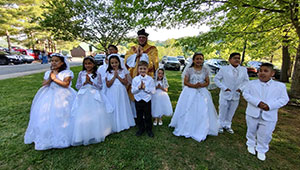 Father Cory Catron finds joy in celebrating the sacraments at St. Frances of Rome Mission in Sparta and St. Francis of Assisi in Jefferson. Father David McCanless is pastor of Our Lady of Mercy Church and Our Lady of Fatima Mission, both in Winston-Salem. Although just over a mile from the parish church, the mission was created to establish a Catholic presence downtown.
Father Cory Catron finds joy in celebrating the sacraments at St. Frances of Rome Mission in Sparta and St. Francis of Assisi in Jefferson. Father David McCanless is pastor of Our Lady of Mercy Church and Our Lady of Fatima Mission, both in Winston-Salem. Although just over a mile from the parish church, the mission was created to establish a Catholic presence downtown.
“The idea was to mission to people who are in town for conventions or to visit, and there were Masses held later at night for the visitors or those who worked downtown,” Father McCanless says.
About 40 families regularly attend Mass at the mission, he says, many because they like the experience of worship in a smaller, more intimate space.
Without missions in remote areas, many people may not have the chance to live the Catholic faith.
Growing up in Sparta, church assistant Gauldin was raised Baptist but was always fascinated with the Catholic faith. The mother of two and grandmother of three finally joined the Church in 2014, where the St. Frances of Rome Mission faith community was waiting for her.
“It’s just been the best thing in my life – ever,” she says. “I was so welcomed into this church. It was home when I walked in the door. This was where I was supposed to be. My hope is that everyone feels as welcomed as I did, and I try to make sure that they do.”
Becoming a parish
Ultimately the priests, deacons and laypeople work and pray that their mission community will grow to become a parish and have a full-time pastor. That means becoming sustainable – financially, administratively and in membership – not just now, but for the foreseeable future.
Father Jason Barone has a rare perspective. In 2019, he became the parochial administrator of two mountain missions at the same time: Our Lady of the Mountains in Highlands and St. Jude in Sapphire, which was pining to become a parish.
“It was a strange situation initially because I was a priest serving over two missions looked over by two parishes in two different vicariates of the diocese,” Father Barone says.
Father Barone nurtured both and is grateful to have experienced the elevation of St. Jude from mission to parish on July 5, 2022. And he was installed as its first pastor.
Father Cory Catron of the Sparta mission says the “ministry of presence” was emphasized in the seminary – and that’s what it takes to elevate a mission to a parish.
“The way we’re going to grow to that level is starting with the presence of the priest,” he says. “It starts with an active liturgical and devotional life in the parish. We’re not a social club. We’re there primarily for the service of God, and so if we start with a priest and the worship of God being our focal point, we can’t help but grow.”
— Annie Ferguson. Christina Lee Knauss contributed.
What is the difference between a mission and a parish?
There are few fundamental differences between a parish and a mission, as both have communities that gather together for worship and support the life of their Church.
A mission church is located within the boundaries of a parish that has an established parish church, which typically shares in the life of the mission – spiritually, financially and administratively. Generally, missions are established to serve the faithful in more rural or remote locations, bringing the fullness of the Church to those who live far away from larger cities and parish churches. Missions usually do not have permanent pastors.
The pastor of the parish church often serves both congregations. Together, they are considered one parish family.
Memories of a mission
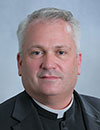 Monsignor Patrick Winslow loved serving the mountain towns of Jefferson and Sparta from 2004 to 2006. One of the largest parishes geographically, he would race 40 miles over hill and dale from St. Francis of Assisi in Jefferson to its mission in Sparta, St. Frances of Rome.
Monsignor Patrick Winslow loved serving the mountain towns of Jefferson and Sparta from 2004 to 2006. One of the largest parishes geographically, he would race 40 miles over hill and dale from St. Francis of Assisi in Jefferson to its mission in Sparta, St. Frances of Rome.
“There was little that separated the two churches except for the physical distance. It was a very loving atmosphere, a wonderful opportunity to get to know people of the North Carolina mountains. And they were so grateful to have a priest, very supportive.”
He recalls the time, on Easter Sunday, when he was sick but felt compelled to get to the mission – and got a speeding ticket on the way. It was a hard day, but he says, “the warmth of my parish family reminded me of my blessings…Our missions are like seeds planted in the vineyard, sprouting and growing while awaiting the Lord’s return.”



